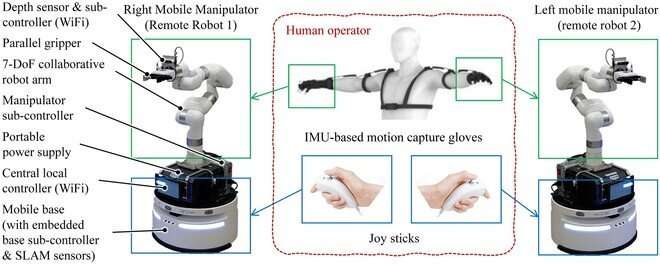
Imagine lying on a bed, you just have to move your fingers to guide a mobile robot to bring you a cup of water, open the door to fetch some deliveries, or even do some laundry. If you are interested, you may want to learn more about a new remotely operated robotic system based on two mobile manipulators. This system was developed by roboticists from Osaka University. They published a research paper describing this robotic system in the journal Cyborg and Bionic Systems.
Back in the year of 2013, Fukushima nuclear power plant witnessed a catastrophic radioactive leakage and contamination, which makes the surrounding area extremely dangerous for humans to stay and perform emergency tasks. Under this circumstance, many robots were deployed and controlled remotely, which greatly reduced the risks and harm to rescuers. Since then, remotely operated robotic systems have been a hot research topic.
“More than being used in radiation-exposed areas, there were also many field robots developed for collecting data at distant damaged sites caused by earthquakes or other man-made and natural disasters, medical sites without expert doctors, and outer space, etc.,” said the study authors.
“The research interest in remote control has been further signified in the past 2 years as the coronavirus disease 2019 (COVID-19) pandemic restricted people’s movement. A series of robots were developed and remotely deployed at the Wuhan hospitals to assist doctors and patients,” said Weiwei Wan, the corresponding author of this study, from the Graduate School of Engineering, Osaka University.
Compared with former research, which tends to contain one mobile base and one or two robotic arms mounted on this base, this study features two separate mobile bases. Each base is mounted with a manipulator.
Each manipulator-mounted base is controlled by one hand. In particular, the human teleoperator’s poses of each hand were recorded by a motion capture system to control the poses of the respective robotic arm. In addition, the operator can move the two mobile bases using two joysticks. Therefore, these two mobile manipulators can work in a cooperative manner, like how we use our hands.
“The proposed idea of incorporating two independently movable manipulators for motion-tracking-based teleoperation is intriguing. However, there are some inherent issues to be addressed,” said Wan, “First of all, how to map the postures of the human teleoperator’s two arms to the corresponding manipulator’s poses. In addition, how to avoid it when under some circumstances, the manipulator may collide with itself. Moreover, how to remotely monitor the two manipulators with the large operating range.” They believe they have addressed these issues by applying special routines and hand-mounted cameras.
They demonstrate this robotic system by picking up a coffee mug and handing it over using only one mobile manipulator. More importantly, the two mobile manipulators can work in a cooperative manner to pick up and place long sticks.
“Since there are two mobile manipulators, the presented system could keep the advantages of having two arms while extending the human body functions,” said Wan, “The results demonstrated the effectiveness of the proposed system, resulting in extending the human body to a large space while keeping the benefits of having two limbs.”
In the future, they will focus on addressing several remaining problems including a) developing an automatic calibration method to match the direction of the human teleoperator’s arms and the manipulators; b) using a joystick with built-in IMU sensor to allow the teleoperator more flexibly control the joystick; c) minimizing the coordination errors between two manipulators; d) providing a feedback interface for teleoperation in a distant and unseen workspace.
More information:
Yusuke Hirao et al, Body Extension by Using Two Mobile Manipulators, Cyborg and Bionic Systems (2023). DOI: 10.34133/cbsystems.0014
Provided by
Beijing Institute of Technology Press Co., Ltd
Citation:
A remotely operated robotic system based on two mobile manipulators (2023, April 20)
retrieved 20 April 2023
from https://techxplore.com/news/2023-04-remotely-robotic-based-mobile.html
This document is subject to copyright. Apart from any fair dealing for the purpose of private study or research, no
part may be reproduced without the written permission. The content is provided for information purposes only.
Stay connected with us on social media platform for instant update click here to join our Twitter, & Facebook
We are now on Telegram. Click here to join our channel (@TechiUpdate) and stay updated with the latest Technology headlines.
For all the latest Technology News Click Here
For the latest news and updates, follow us on Google News.
